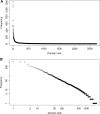Domain mobility in proteins: functional and evolutionary implications
- PMID: 19151098
- PMCID: PMC2722818
- DOI: 10.1093/bib/bbn057
Domain mobility in proteins: functional and evolutionary implications
Abstract
A substantial fraction of eukaryotic proteins contains multiple domains, some of which show a tendency to occur in diverse domain architectures and can be considered mobile (or 'promiscuous'). These promiscuous domains are typically involved in protein-protein interactions and play crucial roles in interaction networks, particularly those contributing to signal transduction. They also play a major role in creating diversity of protein domain architecture in the proteome. It is now apparent that promiscuity is a volatile and relatively fast-changing feature in evolution, and that only a few domains retain their promiscuity status throughout evolution. Many such domains attained their promiscuity status independently in different lineages. Only recently, we have begun to understand the diversity of protein domain architectures and the role the promiscuous domains play in evolution of this diversity. However, many of the biological mechanisms of protein domain mobility remain shrouded in mystery. In this review, we discuss our present understanding of protein domain promiscuity, its evolution and its role in cellular function.
Figures





